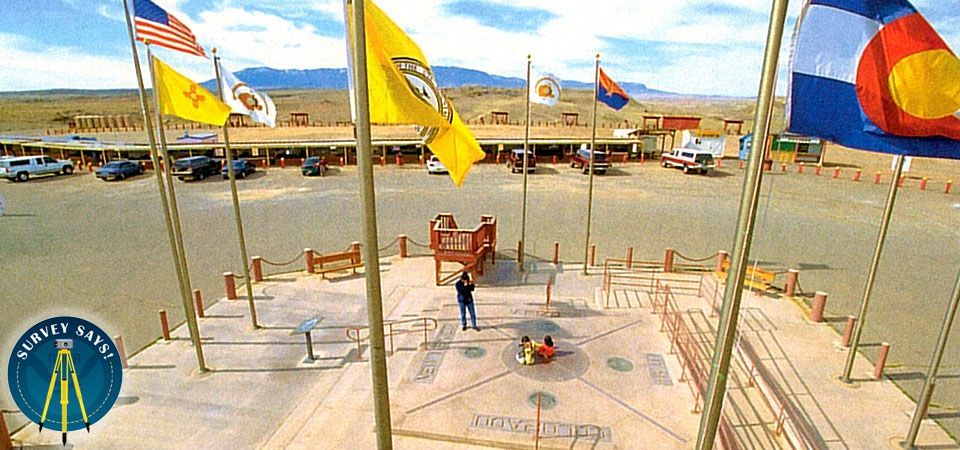Four Corners Monument
Ocean Shorts: Episode 7

Where is Four Corners?
Four Corners Monument is the point where Colorado, Utah, Arizona, and New Mexico meet. You could say that it's also the point where science, history, law, and tradition meet. It's a great example of how surveying can be about much more than taking precise measurements.
Transcript
HOST: You're listening to Ocean Shorts. I'm Troy Kitch. Today we're revisiting a story from a few years back about the Four Corners Monument. That's where Colorado, Utah, New Mexico, and Arizona all meet at one point. We'll hear from Dave Doyle. Dave was chief geodetic surveyor of NOAA's National Geodetic Survey at the time of this interview but he has since retired. So there is a widely held misperception that the longitude of the Four Corners Monument is 109 degrees West from Greenwich, England. But it's actually not. In fact, if you trekked out to the desert and measured your position with a handheld GPS, you'll find that it's actually 109 degrees plus a little bit more. And that's because this boundary wasn't measured from Greenwich when it was recorded back in the 19th century. It's not and never has been at 109 degrees West. Dave Doyle explains.
DAVE DOYLE: The reality is that that was never the definition of the Western boundary of Colorado, [or] the Eastern boundary of Utah. It's actually defined as being 32 degrees longitude West of the Washington meridian, Washington referring to the city of Washington, DC. And the meridian referenced in that statute is now what we refer to as the Old Naval Observatory, in downtown Washington, DC. The Old Naval Observatory has a longitude that is not exactly 77 degrees West of Greenwich. It's 77 degrees, three minutes, and, depending on how you define it, four -- almost five -- seconds. So when you add 32 degrees to that, you should come up with 109 degrees, three minutes, and roughly five seconds. And that three minutes and five seconds of longitude is roughly two and a half miles. And that's where we believe the original discrepancy came from. Someone believed it should be 109 degrees longitude, when that was never how it was statutorily defined.
HOST: And this is where the misunderstanding comes from. The longitude of the position of the Four Corners monument is based on a measurement taken in 1875, and the reference point used then was in Washington, DC. This was before the Prime Meridian was adopted as the standard of measurement by the whole world. Now, if you use today's modern tools to measure that distance from the Old Naval Observatory to the Four Corners boundary, you would find that the position of the monument is off just a bit, somewhere between 1,350 and 1,800 feet. That discrepancy is because the tools used in 1875 were not as accurate. And, to a lesser degree, there's also a slight variation depending on where and how you measure from the Old Naval Observatory. Doyle said that this is a common, everyday issue in the world of surveying. Even though the marker is not precisely 32 degrees West of the Naval Observatory when measured with today's tools, that's irrelevant. And that's because the four states that make up the Four Corners all agreed long ago that the monument, well, it marks the spot. This is what's important to keep in mind about surveying: it's about precision and science, but it's also about history and statutory law. Doyle said that the original 1875 surveyor, a man named Chandler Robbins, got it right. The Four Corners monument is exactly where it's supposed to be.
DAVE DOYLE: It's in its true location. It's exactly where the surveyor at the time placed it. Given the technology that he enjoyed, given the conditions that he had to work under, Mr. Robbins placed that monument exactly where he was directed to, which was 32 degrees West of the meridian of Washington. What he lacked was the contemporary surveying technology that we have today. So in his mind, and based upon all of his observations, and his calculations, he placed the monument exactly 32 degrees longitude West of the Naval Observatory. And that is exactly where it should be, even though its numerical difference today might differ by 1800 feet, or perhaps even if it were two and a half miles, it would become irrelevant, because the monument has subsequently been accepted by all four states as defining the legal boundary, and therefore, it is the monument of record, and in surveying monuments control.
HOST: Thanks for listening to Ocean Shorts. You can send us feedback at nos.info@noaa.gov. And, of course, we're online at oceanservice.noaa.gov.
